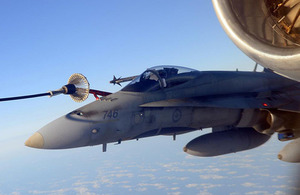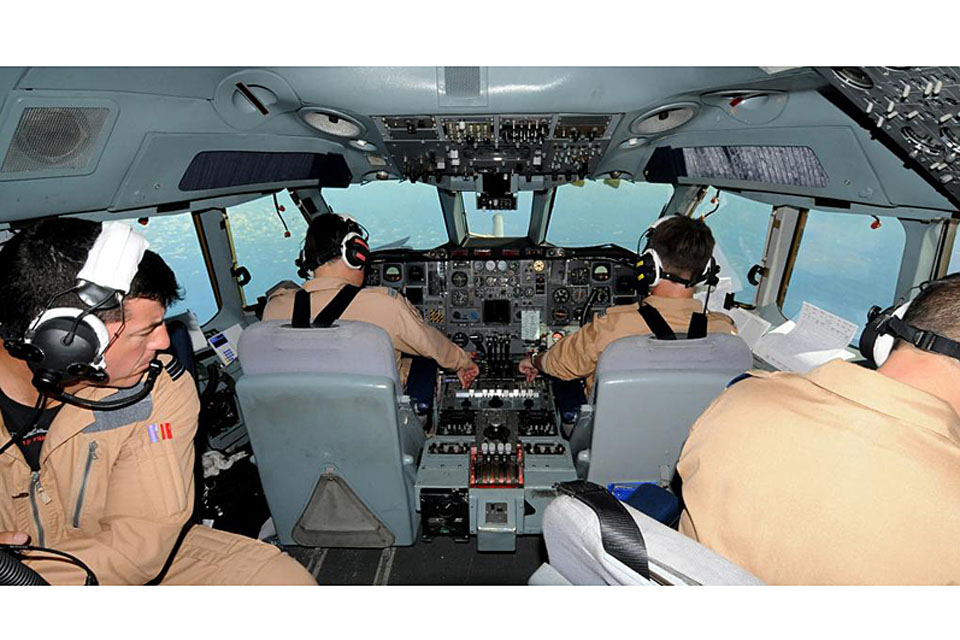RAF tanker aircraft keep missions flying over Libya
RAF VC10 refuelling aircraft from 101 Squadron are providing an essential service to operations over Libya by ensuring NATO sorties can run around the clock and strike targets as the mission demands.

A Canadian F-18 aircraft refuels from a VC10 K3 of 101 Squadron RAF during a mission as part of the NATO-led Operation UNIFIED PROTECTOR [Picture: Senior Aircraftwoman Sally Raimondo, Crown Copyright/MOD 2011]
The fast jets flying over Libya need fuel, and plenty of it, and the VC10 can lift a lot of it to where it’s needed.
The K3 variant flown by 101 Squadron can carry 80 tonnes of fuel and dispense it to a wide range of aircraft from the UK and many other nations taking part in NATO’s Operation UNIFIED PROTECTOR.
The VC10’s four Rolls-Royce Conway engines quickly bring her to take-off speed as she climbs out over the Mediterranean from her current base at Sicily’s Trapani Birgi airport to her first designated refuelling location.
It may be convenient to think of the VC10 as an airborne filling station, but that does everyone involved a disservice.
The fuel load she carries has been carefully calculated in a planning process that begins at NATO’s air headquarters at Poggio Renatico in northern Italy a few days before, and continues until just before take-off.

The flight deck of a 101 Squadron VC10 K3 during a refuelling mission [Picture: Senior Aircraftwoman Sally Raimondo, Crown Copyright/MOD 2011]
Once in the air, that plan can be adjusted to meet the demands of a changing situation. Under the control of a coalition E-3 AWACS (Airborne Warning and Control System) aircraft, often a UK E-3D, the VC10 can move from one refuelling area to another.
No roadside petrol station will come to you, but the VC10 can meet you at a convenient location to support your task.
And the people who fly it love it. One pilot says:
It’s a great aircraft. It really is the Queen of the Skies. It’s one of the last pilot aircraft - you have to have your hands on to fly it. And it still does the job.
On a recent flight, somewhere off the coast of Libya, the first pair of aircraft are expected. The VC10 flight engineer trails a hose from each of the two under-wing pods, ready to provide fuel.
Two Canadian F-18s pull alongside just off one wing. Once they are cleared to refuel, one drops back and comes round the rear of the VC10 to sit behind the other wing. Each aircraft then manoeuvres carefully to plug a refuelling probe into the drogue at the end of the refuelling hose. They then push forward a few feet to start the fuel flowing.
After a few minutes they have enough fuel. They drop off the hoses, reform as a pair on the other wingtip and then break away, disappearing into the distance.
The key role of the VC10 in supporting the NATO coalition is shown by the aircraft served in this mission. After the Canadians, two Italian Harrier aircraft refuel. Then it is the turn of two Spanish F-18s. While RAF fast jets are flying at the same time, their tasking means that they refuel from another nation’s tanker elsewhere.
The utility of the VC10, after long years of service, training with various NATO partners, is that so many different nations’ aircraft can work with her. The fuel she dispenses means those aircraft can spend longer on task, protecting Libyan civilians.
The two VC10s based at Trapani (a third is at RAF Akrotiri on Cyprus) fly up to three missions a day. One aircraft will fly, return, refuel, and fly again later the same day.
The VC10s at Trapani are commanded by Squadron Leader Tim Kemp, who said:
Tanker support is crucial for the fast jets to spend any meaningful time over Libya.
I am proud of what people are achieving here. When we deployed here, there was nothing. We were flying operations within 36 hours of arriving.
As the sun sets, the VC10 returns to Trapani. She has dispensed around 20 tonnes of fuel. Ground crew marshal her back to her parking spot, before ensuring she is serviced, refuelled and ready for tomorrow’s task.
Squadron Leader Kemp concludes:
The fleet is working very hard. We have two aircraft here, one in Akrotiri, two for Operation HERRICK [Afghanistan], one in the Falklands, and one for standby tasking in the UK, as well as continuing to undertake UK-based training and other operational tasking.
We are working very hard but the engineers are pulling it out of the bag to get the job done. We couldn’t be achieving what we’re achieving without the work of the ground crew.
The VC10 is now reaching the end of its service life, but continual modifications maintain the aircraft as a significant asset, enabling the rapid deployment of troops and their weaponry, and fast jet fighter aircraft, to any theatre of operations around the world.
Its replacement, the Airbus A330-based AirTanker aircraft, made its first public appearance in the UK on Friday. Voyager, as the new RAF aircraft has been officially named, flew at the Royal International Air Tattoo at RAF Fairford.